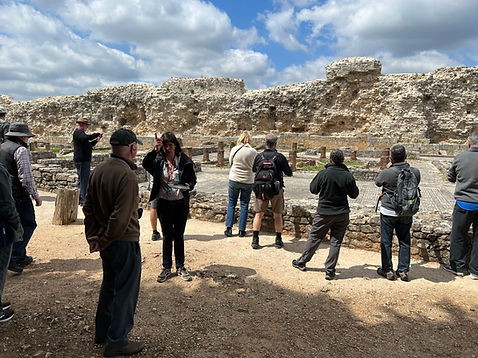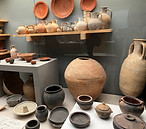
Tomar & Conímbriga
Day 8: May 2
Tomar
This morning we were stepping back in time, first to the 12th Century, when the Knights Templar built the Convent of Christ, an integral part of the defense system securing Portugal against the Moors, and next to the 1st Century BC, when Romans took up occupancy in a settlement of indigenous people, building it into the prosperous town of Conímbriga.
The Convent of Christ was our bonus tour, replacing Bathala, where the worker strike had prevented our entry. The sky was dark and cloudy when we arrived. I thought it set the perfect brooding mood for visiting this massive castle, church and convent complex from the Middle Ages.
The Knights Templar only existed in Portugal until 1312, when the order was dissolved by the king. However, the Pope established the Knights of the Order of Christ, and the former members of the Knights Templar became members of this new order. The Convent of Christ at Tomar had been the seat of the Knights Templar order, and now, seamlessly, it was the seat of the new Order of Christ.
As this complex was built up over the course of five centuries, the architecture is a mix of styles: Romanesque, Gothic, Manueline and Renaissance. I love cloisters and spiral staircases and this complex had lots of them for my enjoyment--eight cloisters and four spiral staircases. We stepped into the small wooden-floor bedrooms where the monks slept, and into the dining hall where they ate on stone benches at long stone tables. We lingered at the most renowned feature of the exterior, the Chapter Window, also known as Manueline Window, noticing the motifs from the sea: ropes, sailors' knots, coral, etc., allowing us to appreciate the dominance of the maritime expeditions of Portugal at the time the window was constructed.
The highlight of the Convent of Christ is the stunning circular church. It is very small compared to the churches we'd seen at the monasteries in Belém and Alcobaça. In the center is a beautiful octagonal structure, richly ornate, full of gilded statues of angels and saints. It is surrounded by the "ambulatory," a gallery of magnificent painting and more statues.
Tomar's Convent of Christ isn't on the Heart of Portugal tour itinerary, but if you're planning to take the tour and want to see more of the country on one of your pre-tour or post-tour days, strongly consider a visit! It is the largest monument in the country and a UNESCO World Heritage Site.




















Conímbriga

As we wandered among the rubbled ruins at Conímbriga, we let our imaginations take us back to when the sandaled feet of Romans walked along these pathways. Conímbriga is not the largest Roman settlement in Portugal, but it is the best preserved, with about 10% excavated. When the Romans began arriving in this area in around 139 BC, this settlement already existed, occupied by indigenous people. The Roman occupation was peaceful and the town was quickly built up and became prosperous. Encircled within its 1,500 meter wall were shops, a forum, a basilica, and a thermal spa, The amphitheater seated 5,000. Most of the homes had two floors and an open courtyard. The elaborate mosaic tile was very well preserved.













The grounds at Conímbriga had lovely flowers and the orange trees smelled so good! Spring is such a great time to travel!
The visitor center at Conímbriga contains a really nice collection of artifacts found during the excavations, including coins, surgical tools, utensils, pottery, jewelry and more. The models and drawings help you envision this community and the lifestyle of the people who settled here 2,000 years ago.








Back in Coimbra






We had a whole free afternoon when we got back to Coimbra. Gary and I used our Rick Steves guidebook to select a restaurant for lunch, but the maze of small, narrow streets and alleyways in that area made finding it a challenge. We stepped into a small hardware store in the hopes that the proprietor might be able to head us in the right direction. Just like everyone else we met in Portugal, he was warm and friendly and eager to help. In fact, quite unnecessarily, he left his shop completely unattended to walk us a block down the street so that he could point out the restaurant in a nearby alley. As described in the guidebook, the restaurant was tiny, and clearly popular, judging by the line of people waiting for a table. We decided to go elsewhere. In Europe, we like to follow Rick's advise of passing on restaurants that try to entice diners inside with a large English-language poster showing glossy pictures of the many food choices. Instead, we look for small restaurants, populated with locals, especially if they have chalkboard menus to list that day's offerings. We stumbled upon just such a place, A Cozinha da Maria. Octopus seems to be on every menu in Portugal and we hadn't had any yet. We each ordered a bowl of soup and we shared an order of grilled octopus and roasted potatoes, a dessert, and a bottle of wine. This delicious lunch turned out to be one of our favorite meals while in Portugal. Our little outdoor table was a great place to linger, enjoy the food and wine, and watch life on the street.
We decided at lunch that we'd spend the rest of our afternoon just strolling. It was a beautiful day and we had some calories to walk off!







There was a laundromat near our hotel. A few in our group were staying in Europe for another couple of weeks following the tour, and they used some of the free time in Coimbra to get some laundry done. Does it look like they're having just a little too much fun to call this a chore? It's great that Rick Steves tours stay in city-center neighborhoods that have laundromats and grocery stores. Washing a load of clothes or popping into the market for a snack is a way to add a slice of normal life to the day. We step out of our tourist shoes for a moment and experience what it would be like to live in a place like this.



In the evening our group had the delightful experience of attending a concert at Fado ao Centro. It is a cultural center that is dedicated to promoting Coimbra's special brand of Fado. Musicians study and rehearse here, giving a public concert at a posted time each day, but Claúdia had arranged for our group to have a private concert. This was an up-close and personal experience, with the four Fado musicians on a small stage in the very intimate-sized theater. For one piece, they taught us the refrain so that we could join in. The words translated to "All this exists, all this is sad, all this is fate." The music was absolutely beautiful, and afterwards we had the fun of chatting with the musicians, and sipping Port with them, in the little courtyard behind the building.



